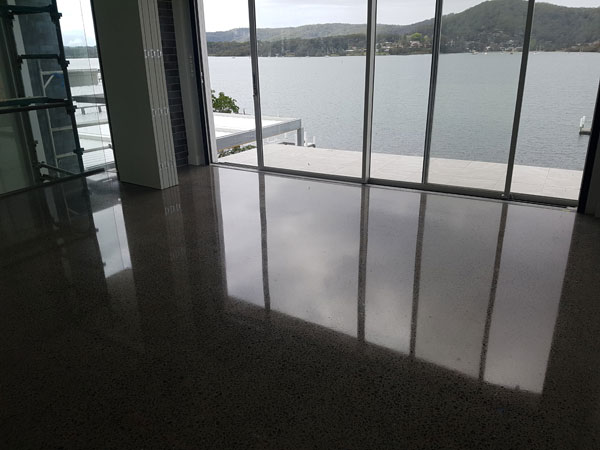MAINTAINING POLISHED CONCRETE FLOORS
Everything needs maintenance
 Fortunately, your diamond polished concrete floor needs less than most. There are three basic parts to keeping your new floor in top condition:
Fortunately, your diamond polished concrete floor needs less than most. There are three basic parts to keeping your new floor in top condition:
- Cleaning
- Refreshing
- Revitalizing
Cleaning is obvious. Daily sweeping or mopping helps keep dirt and grime from building up. Of course, clean up spills of anything as soon as they happen. Your floor is harder and denser that most, so it resists spills better then most. Floors protected with C2 Protector are even more resistant – but clean spills up as soon as you can anyway.
Refreshing is just running a dry high-speed burnisher over the C2 Protector™ or C2 Ultra Seal™ protected floor. This is usually enough, week to week or month to month, to pop that shine right back to “new.” Of course, it'll take some high traffic levels to wear the gloss down enough to where you'll need to refresh. As for residential the time needed to cause this wear is purely based on how wel and often you clean.
Revitalizing means reapplying a thin coat of C2 Protector™ or C2 Ultra Seal™ and burnishing it in. You'll probably appreciate the fact the coating gets re-applied without your having to strip the old coat. And even when revitalizing is needed to bring back the gloss, the protective qualities of C2 Protector™ or C2 Ultra Seal™ are still in full force.
How regularly depends on two things:
- The appearance you want.
- The performance you demand.
If your brilliant, highly polished floor gets thousands of visitors daily, you'll probably want to clean, refresh and revitalize more often then the owner of a steel-troweled floor in a warehouse or your home. It really depends on you and the traffic on your floor. Routine cleaning is important for keeping your floor performing at like-new standards for the lifetime of the floor. Always clean with C2 Maintenance™ and C2 Clean™ if your floor has been polished using this system. They're made for diamond polished concrete floors. See the product data sheets for complete application instructions which are always availble via email.
Routine maintenance for polished floors consists of daily dust mopping to remove dirt and grime accumulation that can abrade the surface of polished concrete. Frequent wet mopping is also needed. Although only clean water can be used, you'll have greater success using a floor cleaner to suspend the dirt particles so they can be more easily removed.Although polished concrete floors are extremely durable through the densification and polishing process, they will eventually lose their beautiful shine if not properly maintained, especially if they are located in high-traffic commercial or retail facilities. The good news is that while polished concrete floors are not maintenance-free, they generally are easier to maintain than other types of decorative concrete floors, since they require no waxing or sealers.
Never use acidic or alkaline cleaners on diamond polished concrete floors.
Checklist for maintaining polished floors:
- Dust mop the floor daily with a microfiber pad to keep dirt particles off the floor. Soils act as an abrasive and can ruin the clarity and shine of polished concrete.
- If wet mopping the floor, always use clean water and clean mops. Use an automatic floor scrubber equipped with a nonabrasive pad to clean large areas. Mop and bucket cleaning can be used in smaller areas and homes.
- When wet mopping, use a neutral floor cleaner formulated to suspend the dirt particles so they can be more easily removed. Using water only leaves much of the dirt on the floor, where it will eventually abrade and discolor the surface.
- Try to clean spills and stains from the floor as quickly as possible so they don't absorb into the surface.
- Make sure the cleaning solution does not dry on the surface. This can be accomplished by cleaning small areas and making sure the entire process is complete before moving on to other areas.
Resources
Download a Brochoure on Cleaning and maintenance please click here
Not Recommended
- Any type of bleach detergent, as this tends to start breaking down the surface.
- Any acid-based products such as vinegar or ammonia.
- Any type of abrasive cleaning cloths such as scouring pads or scrubbers.
- Harsh cleaning detergents on these surfaces as it will diminish the gloss of the surface and may leave unsightly scuffmarks because of the abrasive qualities of these detergents.
 Stains and spills
Stains and spills
Penetrating Stains (i.e. oil, red wine) These types of products can leave a discoloured or darkened area by attaching to the pores in the concrete. These stains can be minimized by timely clean up but if left on the surface for a period can darken and discolour the area.
Reactive stains (i.e. orange juice, acids) These types of products can etch the surface if not cleaned up in a timely manner. In the case of harsh acids etching can occur instantly.
Simple tips
- Fit protective pads to chairs & tables.
- Castor legs should be fitted into castor cups.
- Use a dry mop regularly.
- Avoid direct heat from free standing heaters.
- Spills should be cleaned up straight away to avoid penetration or damage.
- At no point should a steam mop be used on your Machine Polished Floor.
- When washing your floor always leave the kitchen until last.
- Door mats recommend at all doors.











